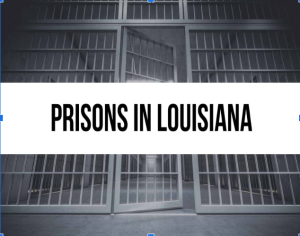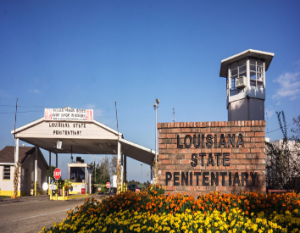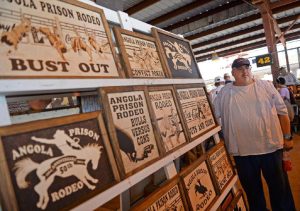8 Louisiana Prison System

Louisiana’s correctional system has a role in history because of Angola Prison, which is officially named Louisiana State Penitentiary and situated on a former slave plantation land area in the state of Louisiana. Angola is recognized as one of the high security prisons across the country with a history that is closely connected to the leasing system that was prevalent in Louisiana for many centuries.
After the Civil War ended and slavery was abolished in the South there was a rise in forms of labor such as convicted leasing. Louisiana especially embraced the practice of widespread reaping profits by renting out inmates. Mainly, African Americans who had been unjustly convicted of trivial or falsely accused crimes. Angola became infamous for its working conditions where prisoners were loaned out to plantation owners, railways, and various enterprises. These brutal situations of leasing in Louisiana are frequently likened to the hardships faced by slaves prior to their liberation, solidifying Angola’s notoriety as a site of misery and exploitation.
The Convict Leasing System in Louisiana
After the abolition of slavery, the South faced a dramatic shift in its economy, particularly in states like Louisiana that had relied heavily on enslaved labor. Convict leasing emerged as a way to continue exploiting African Americans through the criminal justice system (Muller, 2018). Under this system, incarcerated individuals many of whom were African Americans convicted of minor or fabricated crimes were leased out to private businesses, plantations, and industries (Roberts, 2004).
Louisiana was especially notorious for embracing convict leasing as an economic model, reaping significant profits by renting out inmates to plantation owners, railroads, and private enterprises (Norwood & Mancini, 1997). This practice became a cornerstone of the state’s economy, perpetuating a cycle of systemic racial exploitation.
The economic benefits came at a profound human cost. Prisoners were subjected to brutal working conditions, receiving minimal care and suffering high mortality rates (Archibong & Obikili, 2020). In many cases, the treatment of leased convicts was worse than that of enslaved individuals prior to emancipation. Historical records indicate that industries and plantations benefitted immensely from this cheap labor, while African Americans were disproportionately targeted by laws like the Black Codes, ensuring a steady supply of inmates to fuel the convict leasing system (Mancini, 1978).
By the 20th century, attempts to revamp Louisiana’s facilities led to some improvements. Despite this progress, Angola’s severe notoriety continued. The penitentiary became a topic in conversations, about imprisonment racial disparities and prison restructuring, particularly as the state gained recognition as the “Prison Capital of the World”, because of its substantial incarceration rates.
The Legacy of Convict Leasing in Louisiana
The convict leasing system did not survive the emancipation, but it set the stage for many of the problems that are still today a part of Louisiana’s economy, prison and race relations in incarceration. Rather it set the stage for many of the problems that are still seen today especially at Angola Prison which is also known as the Louisiana State Penitentiary.
Reforms at the beginning of the twentieth century aimed at the improvement of the state’s prisons, but some of the practices of the past were carried on at Angola. The very fields where the enslaved people and leased prisoners worked were transformed into the places where prisoners had to perform agricultural work under the same, if not even worse, conditions.
The legacy of the convict leasing system can be seen in three (3) key areas:
- Racial Disparities in Incarceration
The African Americans who were the victims of the convict leasing system also form the large part of today’s Louisiana’s prison population. Some of the policies include mandatory sentencing and severe punishment for petty crimes which has also perpetuated the existing inequalities that can be traced back to the post-slavery era. Despite the changes that have been made in the past decades, these disparities still remain as one of the key aspects of the criminal justice system in the state.
2. Prison Labor Practices
This is reflected in the fact that Angola’s dependence on forced labor of prisoners is a remnant of the convict leasing system. The prisoners still work in the agricultural sector, tending to the crops that were grown with the use of the enslaved and leased labor. Also, other rather questionable projects, such as the Angola Prison Rodeo, have also raised an issue of using inmates as cheap labor with the only goal claimed to be their rehabilitation.
Thus, it is claimed that labor offers prospects for skill development, at the same time, the wages for inmate work are virtually zero, which is a few cents per hour, which definitely provokes the question of exploitation, fairness and equity.
3. Louisiana’s “Prison Capital” Reputation
Louisiana has the highest rates of incarceration in the United States, and this has been caused by strict sentencing laws and punitive policies that have earned the state the title of ‘Prison Capital of the World’. The state’s system shows that the culture of the state has not changed much, as it still emphasizes more on punishment than on rehabilitation. Overcrowding, racial inequality and the social consequences of mass incarceration are still critical issues that show how the practice of convict leasing is still present in the system.
This reputation represents the difficulties of trying to change one of the largest prison systems in the world while also understanding the heritage of the system as being one of exploitation and racism.
The history of convict leasing is a painful chapter that demonstrates how systems of oppression have continued to influence correctional systems in Louisiana. Currently, Angola Prison is remembered as one of the manifestations of this painful past and serves as the epicenter of discussions regarding labor in prisons, race issues, and the possibilities for change in the penal system.
Modern-Day Angola and Its Practices
Angola Today: An Overview
The Louisiana State Penitentiary, commonly known as Angola, is one of the largest maximum-security prisons in the United States. Situated on a sprawling 18,000-acre property once used as a plantation, Angola houses over 5,000 inmates, the majority of whom are serving life sentences without the possibility of parole (Vernon & Saxon, 2020). Angola’s location, size, and historical connections to slavery and convict leasing have made it a powerful symbol of the enduring legacy of racial and economic injustice in the American criminal justice system (Blackmon, 2008).
The prison’s reputation is marked by both its vast agricultural operations and the controversies surrounding its treatment of inmates. Angola operates much like a self-sustaining institution, with inmates cultivating crops such as cotton, corn, and soybeans on the same fields worked by enslaved individuals and leased convicts in the 19th and early 20th centuries (Oshinsky, 1996).
Labor Practices and Rehabilitation Programs
Angola’s labor practices remain deeply tied to its historical roots. Inmates continue to perform agricultural labor under strict supervision, earning wages that are often as low as 4 cents per hour (Burnett, 2021). Critics argue that these conditions bear striking similarities to the exploitative practices of convict leasing, as inmates are effectively forced to work for little compensation while contributing to the prison’s financial sustainability (Thompson, 2010).
Despite these criticisms, Angola offers several vocational and rehabilitation programs aimed at reducing recidivism and providing inmates with practical skills. These include educational opportunities, carpentry and farming training, and faith-based initiatives such as the New Orleans Baptist Theological Seminary’s on-site degree program. Supporters of these programs emphasize their potential to prepare inmates for eventual reentry into society, though such opportunities are limited for the majority of Angola’s population, given the high number of life sentences (Vernon & Saxon, 2020).
The Angola Prison Rodeo
Photo: Handcrafted signs displayed at the Angola Prison Rodeo; an annual event held at the Louisiana State Penitentiary
One of Angola’s most controversial modern practices is the Angola Prison Rodeo. Held twice a year, this event attracts thousands of visitors and serves as a fundraising effort for prison programs. Inmates participate in rodeo events, selling handmade crafts and artwork to visitors (Burkhalter, 2019).
Supporters of the rodeo argue that it provides inmates with opportunities to develop skills, earn money, and interact with the outside world. However, critics contend that the rodeo commodifies incarcerated individuals, reducing their labor and participation to a spectacle for public consumption (Thompson, 2010). The rodeo’s profits primarily benefit the prison, raising ethical questions about the balance between rehabilitation and exploitation.
Persistent Issues
Despite reforms and modernization efforts, Angola remains emblematic of the systemic challenges within Louisiana’s correctional system. Key issues include:
- Overcrowding and Harsh Sentencing Laws: Louisiana’s sentencing policies, including mandatory minimums and life without parole for certain offenses, contribute to its exceptionally high incarceration rates. As a result, Angola continues to house a large population of elderly inmates, many of whom require specialized medical care (Burnett, 2021).
- Inmate Treatment and Solitary Confinement: Advocacy groups have criticized Angola for its use of solitary confinement and inadequate healthcare. Reports indicate that conditions for some inmates fall below basic human rights standards, exacerbating physical and mental health challenges (ACLU, 2017).
- Racial Disparities: The disproportionate incarceration of African Americans remains a persistent issue in Louisiana. Angola’s inmate demographics reflect broader racial disparities in the state’s criminal justice system, with African Americans comprising the majority of the prison’s population (Alexander, 2012).
These issues highlight the ongoing tension between Angola’s efforts to modernize and its deep ties to a punitive and racially biased past. While reform efforts such as parole expansions and alternative sentencing programs have been introduced, meaningful change remains slow and uneven across the system (Walsh, 2016).
Modern Reforms in Angola and the Legacy of its History
Today, Angola is still there housing over 5,000 inmates, with most of them serving life sentences. The prison’s grim past is evident in aspects such as the fields where inmates labor and the controversial prison rodeos prompt ethical concerns on how incarcerated individuals are treated. Louisiana’s correctional systems bear the lingering impact of practices like convict leasing reflecting those challenges such as inequality, overcrowding and the human toll of imprisonment.
Louisiana, and particularly Angola Prison, has seen some reforms in recent years, though these changes have been slow and met with significant challenges. Angola’s longstanding history of racial disparities and its origins as a slave plantation continue to influence its policies and operations today. While the prison has undergone some modernization and improvements, including offering educational programs, work-release initiatives, and faith-based rehabilitation, the shadow of its past is still there.
In recent years, there have been efforts to address issues such as prison overcrowding and harsh sentencing policies, especially for those non-violent offenders (Walsh, 2016). These reforms have included reducing the number of people incarcerated for drug offenses and expanding parole opportunities for certain inmates. However, Angola remains known for its large population of inmates serving life sentences without the possibility of parole, reflecting Louisiana’s historically strict sentencing laws.

Photo: Louisiana State Penitentiary, also known as Angola, one of the largest maximum-security prisons in the U.S., Located in Angola, Louisiana.
One significant reform was the 2017 criminal justice overhaul, which aimed to reduce the state’s high incarceration rate (the highest in the world) at the time. This reform package led to a reduction in the prison population by reclassifying non-violent offenses, granting parole to inmates convicted of certain crimes, and introducing alternative sentencing programs, such as drug courts. Despite these reforms, Angola continues to face criticism over conditions such as solitary confinement, inadequate healthcare, and the treatment of elderly inmates, many of whom are serving life sentences for crimes committed decades ago.
The prison’s labor programs, including the controversial Angola prison rodeo, also remain a focal point of debate. Many argue that the conditions for inmate labor mirror the exploitative practices of the convict leasing system. The historical legacy of convict leasing and slavery, as embodied by Angola’s past, continues to shape public discourse and policy debates in Louisiana. Activists and reform advocates push for further changes, particularly in the areas of sentencing reform, restorative justice, and improving conditions for inmates, while critics argue that the state’s criminal justice system remains deeply rooted in punitive practices rather than rehabilitation.
The prison’s labor programs, including the controversial Angola prison rodeo, also remain a focal point of debate. Many argue that the conditions for inmate labor mirror the exploitative practices of the convict leasing system. The historical legacy of convict leasing and slavery, as embodied by Angola’s past, continues to shape public discourse and policy debates in Louisiana. Activists and reform advocates push for further changes, particularly in the areas of sentencing reform, restorative justice, and improving conditions for inmates, while critics argue that the state’s criminal justice system remains deeply rooted in punitive practices rather than rehabilitation.
This ongoing tension between Angola’s past and the push for modern eforms highlights the complex relationship between history and contemporary prison policies in Louisiana. As such, Angola continues to serve as both a symbol of the deeply ingrained issues with the American prison system and a site for potential change and progress.
Exercises
- Discussion Question: How has the history of Angola Prison, from its origin as a slave plantation to its role in the convict leasing system, influenced modern prison policies in Louisiana? What lessons can be learned from this history in shaping future prison reforms?
- Write a reflective essay on how the history of the Angola Prison System affects the criminal justice system today. Can it be understood about the past prison reform system and racial disparities of incarcerated persons connect with the current debates?

